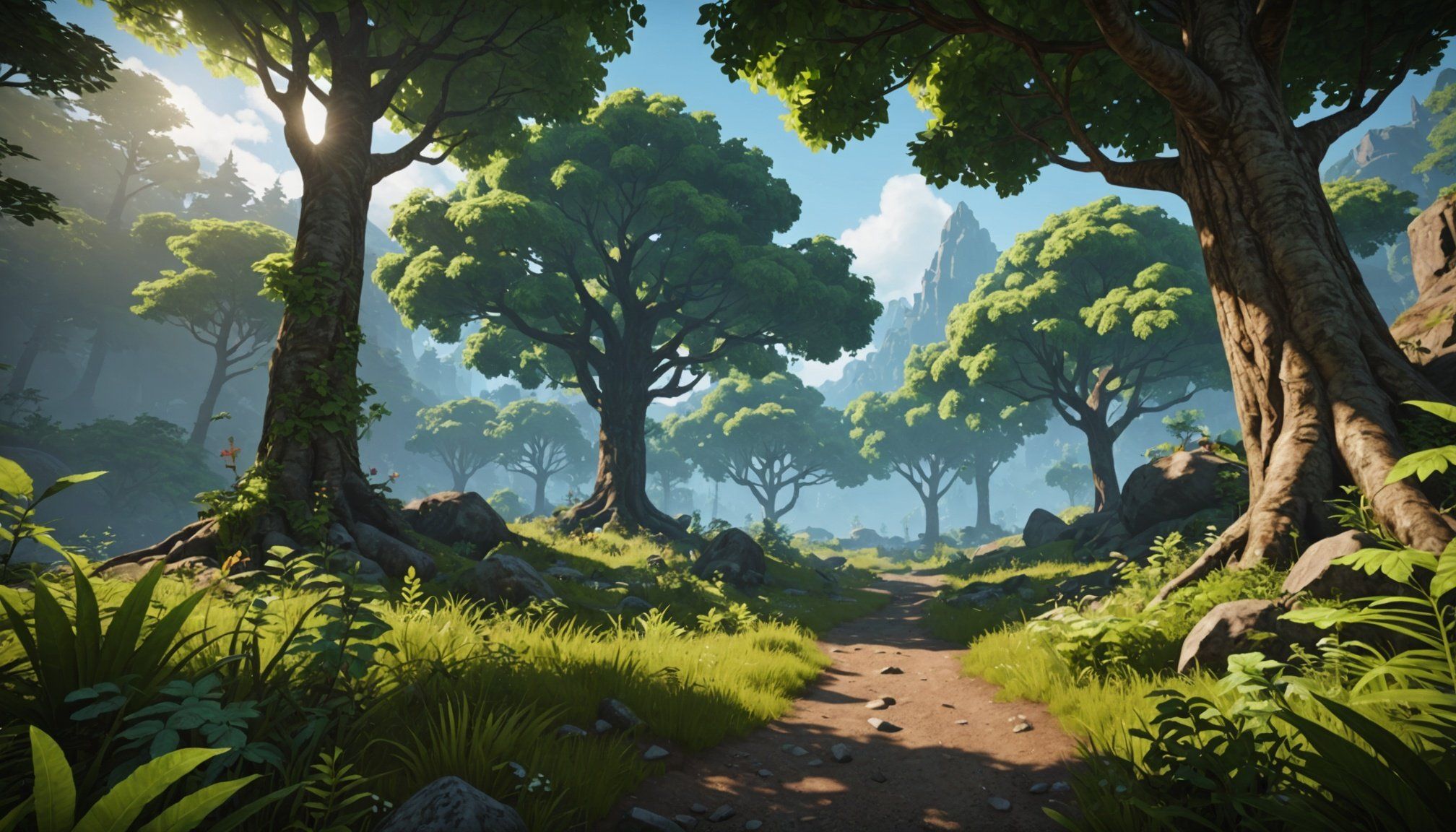Understanding Realistic Foliage in Exploration Games
Realistic foliage is vital for immersing players in exploration games, contributing significantly to the overall atmosphere and believability of a virtual world. By meticulously crafting vegetation, game designers enrich the player’s experience, making landscapes feel vibrant and alive.
Designing such foliage involves a combination of artistic principles that focus on both aesthetics and functionality. Artists draw upon techniques from visual composition to ensure that foliage is not only pleasing to look at but also serves gameplay purposes. Elements like color balance, texture detail, and spatial arrangement are carefully considered. This equilibrium between artistry and playability is pivotal in capturing the essence of natural environments.
Additional reading : Unlocking Haptic Feedback in Mobile AR Gaming: Essential Strategies and Innovative Solutions Revealed
Several exploration games have set the standard for incorporating realistic foliage. Titles like “The Legend of Zelda: Breath of the Wild” and “Red Dead Redemption 2” are prime examples, demonstrating how lush landscapes contribute to an immersive setting. These games have successfully implemented advanced rendering techniques and dynamic weather systems to mimic real-world ecosystems.
In formulating realistic foliage, it’s essential to study these successful implementations. Analysing their methods can provide valuable insights into how vegetation design not only enhances visual appeal but also player engagement and narrative depth.
This might interest you : Mastering Multiplayer Adventures: Designing Innovative VR Experiences for Tomorrow
Essential Tools and Software for Foliage Creation
In crafting realistic foliage for exploration games, selecting the right tools and software is pivotal. Two prominent game engines frequently used are Unity and Unreal Engine, both offering distinct advantages for foliage creation.
Overview of Popular Game Engines
Unity is celebrated for its user-friendly interface, making it accessible for beginners. It supports a wide range of plugins for enhanced foliage design. However, its graphic capabilities might require additional work for achieving ultra-realistic foliage.
On the other hand, Unreal Engine excels in visual fidelity and is preferred by professionals for its high-quality rendering capabilities. Its powerful foliage toolset allows for detailed and complex vegetation designs, yet it demands a steeper learning curve.
Recommended Software for Foliage Creation
Beyond game engines, software like SpeedTree and Blender provide substantial support for foliage modeling. SpeedTree is specifically designed for plant modeling, offering comprehensive tools for creating lifelike trees and plants. Blender, while primarily a 3D modeling tool, offers flexibility in crafting and texturing foliage assets.
Plugins and Resources for Enhanced Foliage Design
Leveraging community-created plugins and assets can streamline foliage creation. Resources from online communities can significantly enhance the realism of game environments while reducing development time.
Step-by-Step Techniques for Crafting Foliage
In foliage creation, mastering 3D modeling techniques is essential. Start by modeling basic plant structures with simple geometric shapes. Gradually add details like branches and leaves to achieve a more lifelike appearance. Use software like Blender for creating editable models with varied complexity.
Texturing is pivotal to bring realism to these models. It involves applying surface textures that mimic natural characteristics, such as bark on trees or the delicate veining of leaves. Use high-resolution photographs or digitally painted textures to achieve rich detailing. This step enhances the visual appeal significantly, making the foliage look authentic.
Layering techniques play a crucial role in adding depth and creating variety in foliage. This involves arranging multiple layers of textures and models at different levels and positions. The trick is to maintain balance; too many layers can overwhelm, while too few may result in flat, less impactful visuals. Proper layering adds richness and complexity to vegetation, contributing to an immersive environment.
By combining these foliage creation techniques, game designers can craft intricate and visually engaging virtual landscapes. Each step, from modeling to texturing and layering, is integral in creating foliage that resonates with realism in exploration games.
Artistic Principles Behind Foliage Design
Understanding the artistic principles behind foliage design is crucial for creating visually compelling environments in game art. These principles ensure that foliage not only looks realistic but also contributes to the overall visual composition.
Color Theory in Foliage
Incorporating color theory is pivotal to achieving believability in foliage. Different hues and tones can mimic the variations found in nature, enhancing the natural beauty of virtual landscapes. Designers often use complementary colors to highlight contrasts between sunlit leaves and those in shadow, achieving depth and a more dynamic look.
Composition Techniques for Effective Foliage Placement
Foliage placement plays a significant role in storytelling within a game. Effective composition techniques involve strategically placing plants to guide the player’s attention or evoke specific emotions. By considering balance and symmetry, designers can create an aesthetically pleasing arrangement that supports the narrative flow.
Natural Patterns and Movement in Foliage Design
Realistic foliage design also integrates natural patterns and movement, such as the sway of grass in the breeze. By simulating these elements, designers can add dynamism and life to static scenes. Techniques include using algorithms that replicate organic growth patterns, ensuring an authentic representation of nature’s unpredictability.
Optimization Techniques for Foliage in Games
Optimizing foliage in games is crucial to ensure smooth performance without sacrificing visual appeal. Performance optimization targets reducing the computational load, which is especially important in exploration games with expansive environments.
Balancing Visual Quality with Performance
Balancing visual quality requires careful adjustment. Developers often employ techniques like Level of Detail (LOD), which adjusts the complexity of foliage models based on the camera’s distance. Closer models display greater detail, enhancing visual appeal, whereas distant objects are simplified to conserve resources.
Polygons can heavily impact game performance. Reducing polygon count of foliage models involves simplifying shapes without noticeably compromising appearance. Using low-polygon models for background vegetation while reserving detailed models for foreground enhances efficiency.
Techniques for Reducing Polygon Count
Techniques such as texture baking, where lighting effects and details are incorporated into textures rather than geometry, significantly enhance performance. Additionally, layers of 2D sprite billboards create an illusion of depth with minimal polygons.
Developers strive to maintain visual fidelity through strategic optimization. This enables exploration games to deliver rich, immersive landscapes without compromising performance, ensuring players enjoy fluid gameplay even in dense, foliage-rich environments.
Examples of Realistic Foliage in Popular Exploration Games
Realistic foliage implementation can dramatically impact the player’s experience in exploration games. Let’s explore how it’s executed effectively.
Analysis of Foliage in Key Exploration Titles
Games like “The Legend of Zelda: Breath of the Wild” and “Red Dead Redemption 2” exemplify foliage implementation by using advanced rendering techniques. These titles employ dynamic weather and lighting systems, allowing foliage to respond realistically, enhancing player immersion. Through attention to detail, such games create a whirlwind of realistic environments including forests, meadows, and riverbanks.
Lessons Learned from Successful Games
Success in these games stems from the balance between artistic principles and performance. Developers focus on color contrasts, soundscapes, and interaction possibilities, ensuring living landscapes. Techniques such as texture layering and movement simulations are paramount. By analyzing top games, developers can gain insights into effective vegetation design and its role in storytelling and gameplay.
Community Feedback and Modifications
The influence of the gaming community on foliage design should not be underestimated. Feedback often leads to mods that enhance or alter vegetation. Community-created mods can introduce novel elements, driving further innovations. This interaction supports developers and provides gamers with enriched options, ensuring an evolving and engaging game experience.











